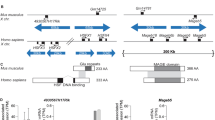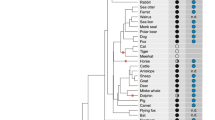Abstract
The male-specific region of the Y chromosome is evolutionarily predisposed to accumulate genes important for spermatogenesis. Recent work in this laboratory identified two novel Y-linked transcripts that were upregulated in the testis in response to deletions on the chromosome arm Yq. This article reports the further characterisation of these two transcripts and their comparison to related X and autosomal genes. Both map to chromosome arm Yp, outside the Sxr b deletion interval, both are present in at least two copies on the Y, and both are expressed specifically in spermatids. Given the testicular phenotype of mice with deletions on the Y chromosome, both genes are therefore likely to function in spermatid differentiation. AK006152 is a novel mouse-specific gene with a single potential open reading frame, and it is unusual in that there appears to be no X-linked relative. H2al2y is a novel histone in the H2A superfamily and has multiple X-linked relatives and a single autosomal relative in mouse. The presence of a single X-linked copy in rat suggests that H2al amplification is mouse-specific, with the alternative explanation being an earlier amplification followed by gene loss. A phylogenetic analysis of H2al genes together with other H2A genes indicates that H2al is most closely related to the mammalian-specific H2A.Bbd family of histones. Interestingly, K a/K s analysis indicates that the X and Y members of the H2al family may be under positive selection in mouse, while the autosomal copy is under purifying selection and presumably retains the ancestral function.





Similar content being viewed by others

References
Bao Y, Konesky K, Park YJ, Rosu S, Dyer PN et al (2004) Nucleosomes containing the histone variant H2A.Bbd organize only 118 base pairs of DNA. EMBO J 23:3314–3324
Burgoyne PS (1998) The role of Y-encoded genes in mammalian spermatogenesis. Semin Cell Dev Biol 9:423–432
Burgoyne PS, Mahadevaiah SK, Sutcliffe MJ, Palmer SJ (1992) Fertility in mice requires X–Y pairing and a Y chromosomal “spermiogenesis” gene mapping to the long arm. Cell 71:391–398
Chadwick BP, Willard HF (2001) A novel chromatin protein, distantly related to histone H2A, is largely excluded from the inactive X chromosome. J Cell Biol 152:375–384
Conway SJ, Mahadevaiah SK, Darling SM, Capel B, Rattigan AM et al (1994) Y353/B: a candidate multiple-copy spermiogenesis gene on the mouse Y chromosome. Mamm Genome 5:203–210
Doyen CM, Montel F, Gautier T, Menoni H, Claudet C et al (2006) Dissection of the unusual structural and functional properties of the variant H2A.Bbd nucleosome. EMBO J 25:4234–4244
Eirín-López JM, Ishibashi T, Ausió J (2008) H2A.Bbd: a quickly evolving hypervariable mammalian histone that destabilises nucleosomes in an acetylation-independent way. FASEB J 22:316–326
Ellis PJ, Affara NA (2006) Spermatogenesis and sex chromosome gene content: an evolutionary perspective. Hum Fertil (Camb) 9:1–7
Ellis PJ, Clemente EJ, Ball P, Touré A, Ferguson L et al (2005) Deletions on mouse Yq lead to upregulation of multiple X- and Y-linked transcripts in spermatids. Hum Mol Genet 14:2705–2715
Ellis PJ, Ferguson L, Clemente EJ, Affara NA (2007) Bidirectional transcription of a novel chimeric gene mapping to mouse chromosome Yq. BMC Evol Biol 24:171
Govin J, Escoffier E, Rousseaux S, Kuhn L, Ferro M et al (2007) Pericentric heterochromatin reprogramming by new histone variants during mouse spermiogenesis. J Cell Biol 176:283–294
Graves JAM (1995) The origin and function of the mammalian Y chromosome and Y-borne genes—an evolving understanding. Bioessays 17:311–321
Jørgensen FG, Hobolth A, Hornshøj H, Bendixen C, Fredholm M et al (2005) Comparative analysis of protein coding sequences from human, mouse and the domesticated pig. BMC Biol 3:2
Kamakaka RT, Biggins S (2005) Histone variants: deviants? Genes Dev 19:295–310
Li WH (1993) Unbiased estimation of the rates of synonymous and nonsynonymous substitution. J Mol Evol 36:96–99
Ma K, Inglis JD, Sharkey A, Bickmore WA, Hill RE et al (1993) A Y chromosome gene family with RNA-binding protein homology: candidates for the azoospermia factor AZF controlling human spermatogenesis. Cell 75:1287–1295
Makalowski W, Boguski MS (1998) Evolutionary parameters of the transcribed mammalian genome: an analysis of 2,820 orthologous rodent and human sequences. Proc Natl Acad Sci USA 95:9407–9412
Mariño-Ramírez L, Hsu B, Baxevanis AD, Landsman D (2006) The Histone Database: a comprehensive resource for histones and histone fold-containing proteins. Proteins 62:838–842
Mazeyrat S, Saut N, Grigoriev V, Mahadevaiah SK, Ojarikre OA et al (2001) A Y-encoded subunit of the translation initiation factor Eif2 is essential for mouse spermatogenesis. Nat Genet 29:49–53
Reijo R, Lee TY, Salo P, Alagappan R, Brown LG et al (1995) Diverse spermatogenic defects in humans caused by Y chromosome deletions encompassing a novel RNA-binding protein gene. Nat Genet 10(4):383–393
Sargent CA, Boucher CA, Kirsch S, Brown G, Weiss B et al (1999) The critical region of overlap defining the AZFa male infertility interval of proximal Yq contains three transcribed sequences. J Med Genet 36:670–677
Styrna J, Klag J, Moriwaki K (1991) Influence of partial deletion of the Y chromosome on mouse sperm phenotype. J Reprod Fertil 92:187–195
Sun C, Skaletsky H, Birren B, Devon K, Tang Z et al (1999) An azoospermic man with a de novo point mutation in the Y-chromosomal gene USP9Y. Nat Genet 23(4):429–432
Touré A, Szot M, Mahadevaiah SK, Rattigan A, Ojarikre OA (2004) A new deletion of the mouse Y chromosome long arm associated with the loss of Ssty expression, abnormal sperm development and sterility. Genetics 166:901–912
Touré A, Clemente EJ, Ellis PJ, Mahadevaiah SK, Ojarikre OA et al (2005) Identification of novel Y chromosome encoded transcripts by testis transcriptome analysis of mice with deletions of the Y chromosome long arm. Genome Biol 6:R102
Vallender EJ, Lahn BT (2004) How mammalian sex chromosomes acquired their peculiar gene content. Bioessays 26:159–169
Vicoso B, Charlesworth B (2006) Evolution on the X chromsome: unusual patterns and processes. Nat Rev Genet 7:645–653
Vogt PH, Edelmann A, Kirsch S, Henegariu O, Hirschmann P et al (1996) Human Y chromosome azoospermia factors (AZF) mapped to different subregions in Yq11. Hum Mol Genet 5:933–943
Zhang Z, Li J, Zhao XQ, Wang J, Wong GK et al (2006) K a K s calulator: calculating K a and K s through model selection and model averaging. Genomics Proteomics Bioinformatics 4:259–263
Acknowledgments
The authors thank Dr. Paul Burgoyne (NIMR, Mill Hill, London) for the DNA samples from mice with variant Y chromosomes that were used in the mapping of the two novel Yp genes described herein. The work presented in this article was supported by the Biotechnology and Biological Sciences Research Council (8/EGH16106 and BB/F007434/1).
Author information
Authors and Affiliations
Corresponding author
Electronic supplementary material
Below is the link to the electronic supplementary material.
Rights and permissions
About this article
Cite this article
Ferguson, L., Ellis, P.J.I. & Affara, N.A. Two novel mouse genes mapped to chromosome Yp are expressed specifically in spermatids. Mamm Genome 20, 193–206 (2009). https://doi.org/10.1007/s00335-009-9175-8
Received:
Accepted:
Published:
Issue Date:
DOI: https://doi.org/10.1007/s00335-009-9175-8



